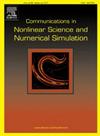A bilevel approach to biobjective inverse optimal control of nonlinear fermentation system with uncertainties
IF 3.8
2区 数学
Q1 MATHEMATICS, APPLIED
Communications in Nonlinear Science and Numerical Simulation
Pub Date : 2025-03-25
DOI:10.1016/j.cnsns.2025.108780
引用次数: 0
Abstract
Inverse optimal control is a framework to deal with the optimal control of dynamical systems with uncertain parameters. Bioconversion of glycerol to 1,3-propanediol in continuous fermentation is a complex cellular metabolic process in nature. Due to the unclear metabolic mechanisms and the lack of experimental data of intracellular concentrations, kinetic parameters of the fermentation system are often to a certain degree uncertain. This paper proposes a biobjective inverse optimal control problem with functional inequality constraints to describe the process control of glycerol continuous fermentation system considering the uncertainties of kinetic parameters, where the objectives are formulated based on the biological robustness and the settling time under approximately stable state. A novel distance-based stochastic comparison principle is designed to handle the complex constraints. A bilevel approach using nested strategy is also constructed to solve the biobjective bilevel problem, which is a combination of whale optimization algorithm with the new comparison principle for the lower level and chaotic competitive differential evolution algorithm for the upper level. Numerical comparisons show that the novel comparison principle has certain advantages in convergence speed for 13 benchmark functions compared with two other constraint handling techniques and the obtained optimal dilution rate is effective to avoid glycerol waste for about 30 h. Numerical results show that the proposed bilevel algorithm is effective and practicable to the complex real problem.
含不确定性非线性发酵系统双目标逆最优控制的双层方法
逆最优控制是研究具有不确定参数的动态系统最优控制的一种框架。甘油在连续发酵过程中转化为1,3-丙二醇是一个复杂的细胞代谢过程。由于代谢机制不明确,细胞内浓度实验数据缺乏,发酵系统的动力学参数往往具有一定程度的不确定性。考虑动力学参数的不确定性,提出了一种带有函数不等式约束的双目标逆最优控制问题来描述甘油连续发酵系统的过程控制,其中目标是基于生物鲁棒性和近似稳定状态下的沉降时间。设计了一种新的基于距离的随机比较原理来处理复杂约束。构造了一种采用嵌套策略的双层方法来解决双目标双层问题,该方法将带有新的比较原理的鲸鱼优化算法作为下层,将混沌竞争差分进化算法作为上层。数值比较表明,与其他两种约束处理技术相比,该比较原理在13个基准函数的收敛速度上具有一定的优势,得到的最优稀释率可有效避免30 h左右的甘油浪费。数值结果表明,本文提出的双层算法对于复杂的实际问题是有效和实用的。
本文章由计算机程序翻译,如有差异,请以英文原文为准。
求助全文
约1分钟内获得全文
求助全文
来源期刊

Communications in Nonlinear Science and Numerical Simulation
MATHEMATICS, APPLIED-MATHEMATICS, INTERDISCIPLINARY APPLICATIONS
CiteScore
6.80
自引率
7.70%
发文量
378
审稿时长
78 days
期刊介绍:
The journal publishes original research findings on experimental observation, mathematical modeling, theoretical analysis and numerical simulation, for more accurate description, better prediction or novel application, of nonlinear phenomena in science and engineering. It offers a venue for researchers to make rapid exchange of ideas and techniques in nonlinear science and complexity.
The submission of manuscripts with cross-disciplinary approaches in nonlinear science and complexity is particularly encouraged.
Topics of interest:
Nonlinear differential or delay equations, Lie group analysis and asymptotic methods, Discontinuous systems, Fractals, Fractional calculus and dynamics, Nonlinear effects in quantum mechanics, Nonlinear stochastic processes, Experimental nonlinear science, Time-series and signal analysis, Computational methods and simulations in nonlinear science and engineering, Control of dynamical systems, Synchronization, Lyapunov analysis, High-dimensional chaos and turbulence, Chaos in Hamiltonian systems, Integrable systems and solitons, Collective behavior in many-body systems, Biological physics and networks, Nonlinear mechanical systems, Complex systems and complexity.
No length limitation for contributions is set, but only concisely written manuscripts are published. Brief papers are published on the basis of Rapid Communications. Discussions of previously published papers are welcome.
 求助内容:
求助内容: 应助结果提醒方式:
应助结果提醒方式:


